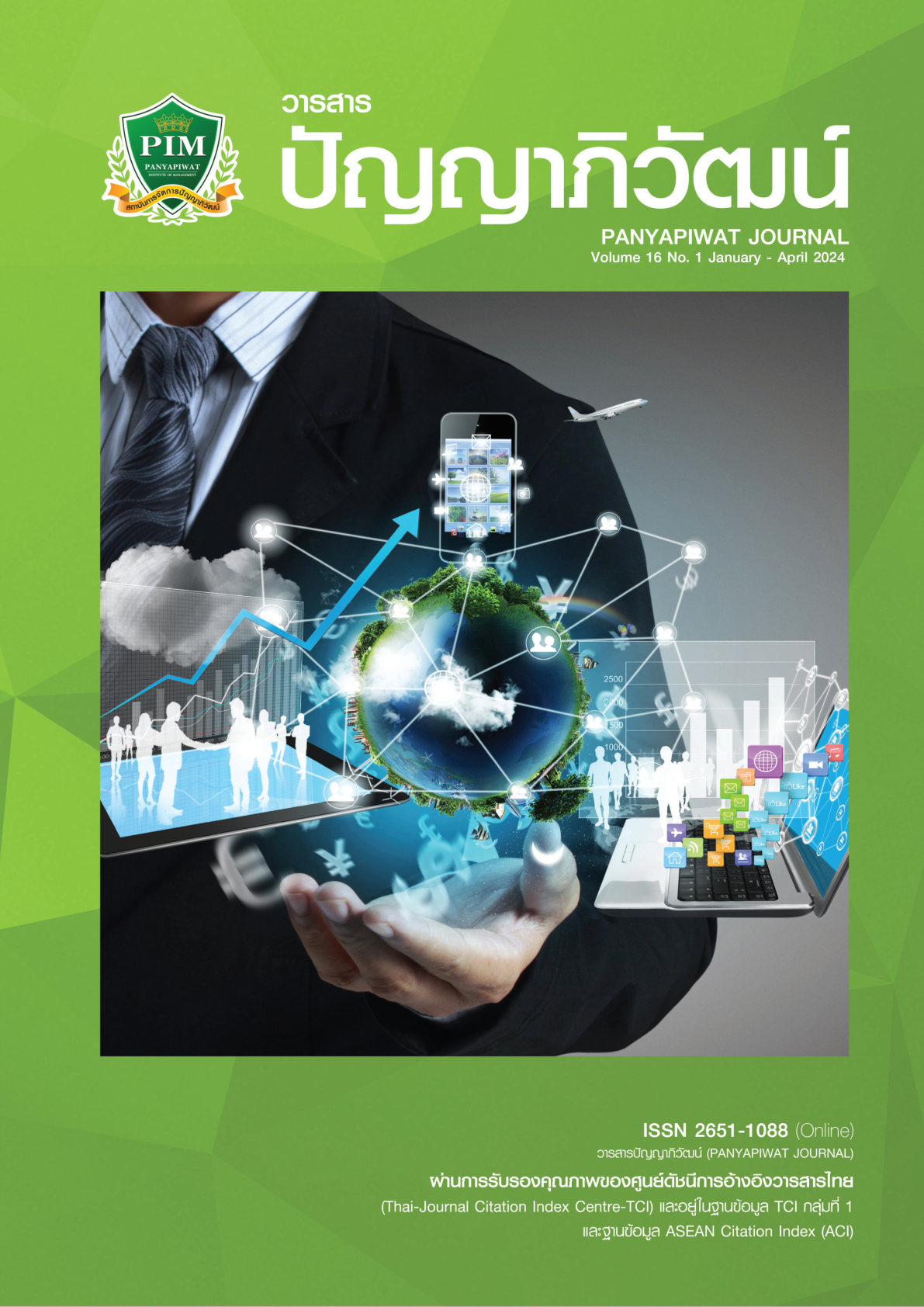ANALYTIC HIERACHY PROCESS OF 7’S INDEX IN DIGITAL INNOVATION MARKETING OF LEADING TECHNOLOGY ORGANIZATIONS INTO THE METAVERSE
Main Article Content
บทคัดย่อ
This quantitative research focuses objectively on the analytic hierarchy of 7’s index process in search of marketing management excellence indicators in the Metaverse of leading technology organizations in Thailand. A questionnaire was used as a tool for research data collection, and the statistics used for data analysis were PAWS version 18.0 and the AHP Online System (AHP-OS). The research findings indicated that the top five marketing management excellence indices for leading technology organizations to the Metaverse were the following factors: the structure of the organization (l = 0.405); staff (l = 0.205); strategy (l = 0.196); skill (l = 0.096); and style (l = 0.043). Five excellent factors of digital innovation were sustainable growth (l = 0.128); human resource development (l = 0.112); brand strength (l = 0.110); new creative innovation development (l = 0.085); and green technology (l = 0.072) respectively. The research results highlight the advantages and value benefits of marketing activity, adopting Metaverse for future growth. In addition, the methodology and results of this study are expected to provide insight into the success of Metaverse’s transformation to thrive in increasing competition.
Article Details

อนุญาตภายใต้เงื่อนไข Creative Commons Attribution-NonCommercial-NoDerivatives 4.0 International License.
“ข้าพเจ้าและผู้เขียนร่วม (ถ้ามี) ขอรับรองว่า บทความที่เสนอมานี้ยังไม่เคยได้รับการตีพิมพ์และไม่ได้อยู่ระหว่างกระบวนการพิจารณาลงตีพิมพ์ในวารสารหรือแหล่งเผยแพร่อื่นใด ข้าพเจ้าและผู้เขียนร่วมยอมรับหลักเกณฑ์การพิจารณาต้นฉบับ ทั้งยินยอมให้กองบรรณาธิการมีสิทธิ์พิจารณาและตรวจแก้ต้นฉบับได้ตามที่เห็นสมควร พร้อมนี้ขอมอบลิขสิทธิ์บทความที่ได้รับการตีพิมพ์ให้แก่สถาบันการจัดการปัญญาภิวัฒน์หากมีการฟ้องร้องเรื่องการละเมิดลิขสิทธิ์เกี่ยวกับภาพ กราฟ ข้อความส่วนใดส่วนหนึ่งและ/หรือข้อคิดเห็นที่ปรากฏในบทความข้าพเจ้าและผู้เขียนร่วมยินยอมรับผิดชอบแต่เพียงฝ่ายเดียว”
เอกสารอ้างอิง
Abbasimehr, H., & Shabani, M. (2021). A new framework for predicting customer behavior in terms of RFM by considering the temporal aspect based on time series techniques. Journal of Ambient Intelligence and Humanized Computing, 12(1), 515-531.
Akter, S., & Wamba, S. (2016). Big data analytics in e-commerce: A systematic review and agenda for future research. Electronic Markets, 26(2), 173-194.
Alshaher, A. A. (2013). The McKinsey 7S model framework for e-learning system readiness assessment. International Journal of Advances in Engineering & Technology, 6(5), 1948-1966.
Alsharari, N. (2021). Integrating blockchain technology with internet of things to efficiency. International Journal of Technology, Innovation and Management (IJTIM), 1(2), 1-13.
Baoguo, L., & Laksitamas, P. (2020). The commercial bank service managers’ job satisfaction in People’s Republic of China. International Journal of Management Studies and Social Science Research, 2(5), 189-198.
Billingsley, P. (2013). Convergence of probability measure. John Wiley & Sons.
Busalim, A. H. (2016). Understanding social commerce: A systematic literature review and directions for further research. International Journal of Information Management, 36(6), 1075-1088.
Channon, D. F., & Caldart, A. A. (2015). McKinsey 7S model. Wiley Encyclopedia of Management, 12, 127.
Cochran, W. G. (2007). Sampling techniques (3rd ed.). John Wiley & Sons.
Damar, M. (2021). Metaverse shape of your life for future: A bibliometric snapshopt. Journal of Metaverse, 1(1), 1-8.
Defence Technology Institute. (2020). Analytic Hierarchy Process: AHP. https://www.dti.or.th/download/150319174753_3ahp4.pdf
Ekka, R. (2014). Research methodology and data analysis in humanities & social sciences. Lulu. com.
Goepel, K. D. (2022). AHP Online system-AHP-OS. https://bpmsg.com/ah
Gola, M. (2020). How to use the 7S model for effective marketing? https://www.curvearro.com/blog/how-to-use-the-7s-model-for-effective-marketing/
Hamid, S., Isa, S., Chew, B., & Altun, A. (2019). Quality management evolution from the past to present: Challenges for tomorrow. Organizacija, 52(3), 157-186.
Kline, R. B. (2023). Principles and practice of structural equation modeling (5th ed.). Guilford Press.
Laksitamas, P., Baoguo, L., Kobayashi, S., Run, P., Ling, C., Slater, M., Guiyu, M., & Pongpaibool, P. (2021). A relationship marketing model towards the environment of online customers in digital 4.0 timing. Natural Volatiles & Essential Oils Journal, 8(5), 10346-10358.
Mononen, V. (2021). Developing a competitor analysis concept for case company customers [Bachelor’s thesis]. Metropolia University of Applied Sciences.
Peter, T. J. (2011). A brief history of the 7-S (“McKinsey 7-S”) model. Tom Peters.
Peters, T. J., & Waterman, R. H. (2015). In search of excellence: Lessons from America’s best-run companies. Profile Books Ltd.
Rovinelli, R. J., & Hambleton, R. K. (1977). On the use of content specialists in the assessment of criterion-referenced test item validity. Dutch Journal of Educational Research, 2, 49-60.
Shen, L., Muduli, K., & Brave, A. (2015). Developing a sustainable development framework in the context of mining industries: AHP approach. Resources Policy, 46(1), 15-26.
Veisi, H., Deihimfard, R., Shahmohammadi, A., & Hydarzadeh, Y. (2022). Application of the Analytic Hierarchy Process (AHP) in a multi-criteria selection of agricultural irrigation systems. Agricultural Water Management, 267(1), 107619.
Yalcin, A., Reis, S., Aydinoglu, A., C., & Yomralioglu, T. (2011). A GIS-based comparative study of frequency ratio, analytical hierarchy process, bivariate statistics and logistics regression methods for landslide susceptibility mapping in Trabzon, NE Turkey. Catena, 85(3), 274-287.


